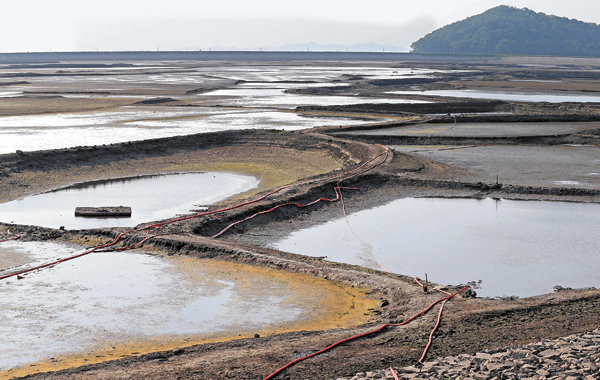Drought could likely affect potable water supply

Farmers in Gangwha County, Incheon, pump water directly from their local reservoir to supply their fields during the enduring drought. In Gyeonggi and Gangwon, total precipitation for this year does not come to even half the normal amount of precipitation in other years. Provided by Shin In-seop
The drought afflicting the central region of the Korean Peninsula has continued to worsen, and total precipitation for the area over the weekend did not exceed 10 millimeters.
If weather conditions remain dry, the Soyang Dam in Chuncheon, Gangwon, will be forced to cease power generation by the end of the month, and problems with the potable water supply may arise.
According to K-Water, the state-supported Korea Water Resources Corporation, Soyang Dam’s water level on Sunday stood at 152.6 meters (500 feet), just 67 centimeters away from falling to its record low of 151.93 meters on June 2, 1978. When the dam’s water level falls to below 150 meters, the dam can no longer generate power and stored water cannot be used for potable water.
Since Thursday, the dam’s downstream flow rate, the amount of water released, dropped from 102 to 103 metric tons (112.4 to 113.5 tons) per second to 52 to 53 metric tons per second.
But despite the adjustment, the dam’s water level has continued to drop and will likely continue to dip with the forecast for the coming days seeing an absence of rain. No precipitation is expected until after June 24.
“It has to rain at least 50 millimeters for the Soyang Dam’s water level to rise again,” said Kim Han-seop, the deputy head of the operations department for the dam. “If the drought continues in accordance with weather forecasts, we may have to stop power generation by the end of the month.”
Rainfall over the weekend in Chungju, North Chungcheong, also wasn’t enough to keep the water level at Chungju Dam from decreasing. The water level in the dam currently stands at 115.13 meters, only 2.85 meters above its record low of 112.28 meters, reached in June 1994.
Dwindling water levels at both the Soyang and Chungju Dams will cause problems with the supply of potable water for the city of Seoul, as water from the two dams channel water into the Han River.
Since Thursday, the Ministry of Land, Infrastructure and Transport has increased the amount of water flowing from the Chuncheon, Uiam and Cheongpyeong dams downstream of the Soyang Dam to ensure that enough water reaches Paldang Reservoir, the main source of water for Seoul. Toxic algal blooms can develop in the reservoir if there is too little water.
“If citizens in the city show a sense of citizenship by conserving water, it’s possible that the drought will not result in [affecting] the water supply,” advised Kim Dae-su, deputy head of the environmental department for management at the Soyang Dam.
While the potable water supply problem arising from the drought has been addressed for the time being by increasing water flow from other dams in the area, agriculture has taken a direct hit from the drought.
In Chuncheon, Gangwon, some farmers have begun plowing over their rice paddies. “Since there’s no water for the rice paddies, I’ve plowed over them to save water in the fields,” said Song Geun-bae, 59, an area farmer.
Some growers have not given up on crop production for the season but are nevertheless remaining realistic.
“Thanks to the rainfall on June 13 and 14, there was no dust in the fields so we began planting soybeans,” said Lee Wan-bae, 62, the head of a village in Paju, Gyeonggi. “But given how dry it is, I don’t have confidence that the beans will grow well.”
Given the inauspicious circumstances, vegetable prices have surged. According to the Korea Agro-Fisheries and Food Trade Corporation, standard selling prices for cabbage across the country last weekend was 800 won (71 cents) per kilogram, approximately 2.5 times the price of cabbage at the same time last year.
At Garak Market in Songpa District, southern Seoul, the price of onions has increased 90 percent from last year, and the price of garlic 73 percent from last year. Since vegetable prices were low last year, prices have skyrocketed this year, with the drought coinciding with a reduction in available arable land.
With 6.1 billion won ($5.5 million) from the government’s drought relief fund and other reserves, local governments have currently committed 34.8 billion won to dig wells and deliver water to places in need.
BY PARK JIN-HO [enational@joongang.co.kr]










with the Korea JoongAng Daily
To write comments, please log in to one of the accounts.
Standards Board Policy (0/250자)